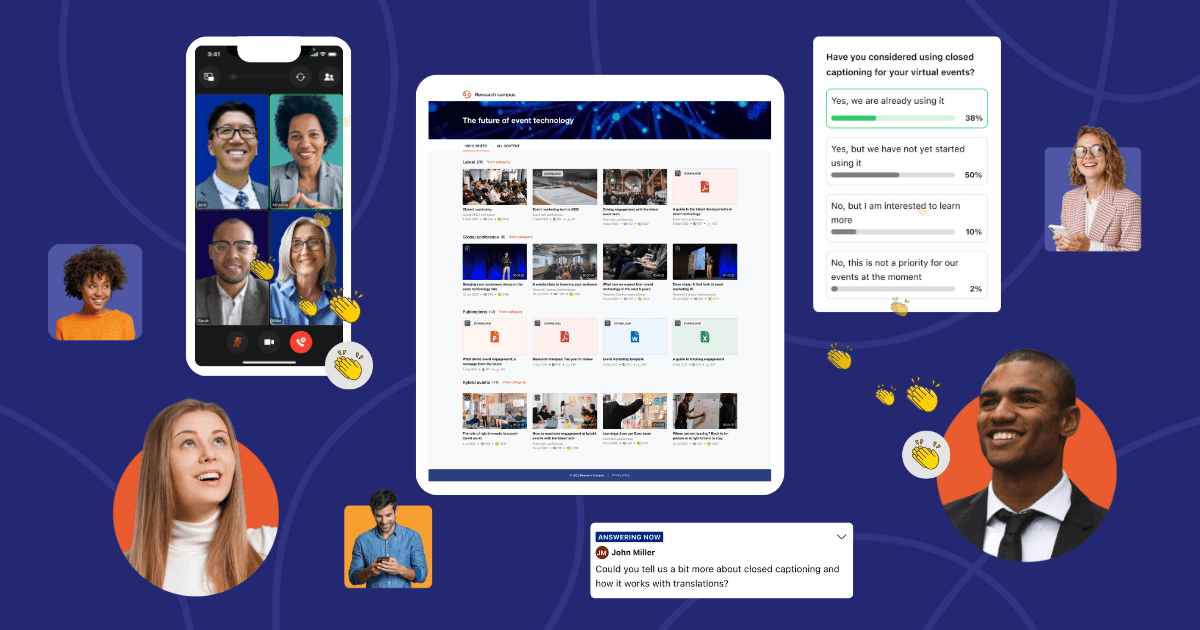
Event engagement is not easy. First, attendees have different expectations, preferences, and interests, so there’s no one-size-fits-all approach. Second, event engagement requires careful planning, execution, and follow-up. This is time-consuming and resource-intensive. Third, measuring the power of event engagement can be challenging because it can be difficult to track metrics.
But high event engagement can create a huge amount of value for your business.
As a Leader in The Forrester Wave™: B2B Event Management Technology, Q1 2023, SpotMe’s superior vision continues to focus “on creating engaging audience experiences and interactions to enrich CRM records.” (Forrester Wave™)
That’s why we’ve created this article. We’ve used our event engagement expertise after working with hundreds of leading life science, professional services, and tech companies to help you build a winning event engagement strategy.
Discover the benefits of a successful event engagement strategy and how to use your event platform alongside your CRM to track engagement data. Then, get 29 event engagement ideas to improve your future events.
What Is Event Engagement?
Event engagement is all about creating a lasting connection between your brand and your attendees. It involves encouraging conversation, providing value before, during, and after the event, and having an impact on how attendees remember their experience. A well-thought-out event engagement strategy can help keep your guests engaged from the moment they sign up all the way through to a week or so after your event.
Building an effective event engagement strategy includes both digital and physical components. It’s important to leverage both for maximum impact. Digital event engagement can take many forms. This could include social media posts, email marketing campaigns, and even chatbot interactions.
Whether you’re organizing a virtual, in-person, or hybrid event, great event engagement is key to creating an impactful, memorable event.
Want your events to stand out this year? Read our article about the 12 corporate event trends you need to know about.
How To Build A Comprehensive Event Engagement Strategy
When most people think of event engagement, they think of how to get participants interacting at their events and that’s it. But if you don’t get your participants interacting with your content before and after your event, you’re missing out on a golden opportunity!
That’s why creating an effective event engagement strategy to keep your attendees engaged before, during, and after your event is essential for building effective experiences.
To start, you need to have your event goals clear in your mind and establish your KPIs. That way, you know what you want to achieve through your event engagement and how you are going to measure its success.
You can then use your event platform to engage your audience and get the data fed automatically back into your CRM for you to analyze at the end.
To help you clearly plan out your KPIs and many other aspects of your event, you need a structured event brief. Download the ultimate event brief template now to make creating your event engagement strategy a breeze.
How To Measure The Success Of Your Event Engagement Strategy
There’s no point in investing a lot of time and effort into event engagement if you don’t measure its success. And that can be difficult if you use lots of different systems to run your events.
But there are some event platforms like SpotMe that have “deep native integrations with CRM systems/MAPs, including vertical-specific ones such as Veeva” (The Forrester Wave™: B2B Event Management Technology, Q1 2023).
That means all the engagement data that’s collected on your event platform gets fed back to your CRM automatically for you to analyze easily.
You can track a wide range of engagement data such as:
- Invitations accepted
- Sessions registered
- Questions asked
- Polls answered
- Forms submitted
- Sessions attended
- Minutes watched
- Moments applauded
- Posts liked
- Notifications acknowledged
- Documents viewed
By tracking these metrics, you can understand which parts of your event were successful and which weren’t so you can make changes for future events. Additionally, you can figure out what content resonated most with attendees and tailor your approach for your future events.
The bottom line is that measuring event engagement results helps you create an effective strategy that will boost ROI while giving attendees a good experience. And integrating your event platform with your CRM is a great way to have a single source of truth to help you drive your next best action.
To get a clear view of what KPIs to measure at your events, check out our article with 19 event metrics you should be measuring.
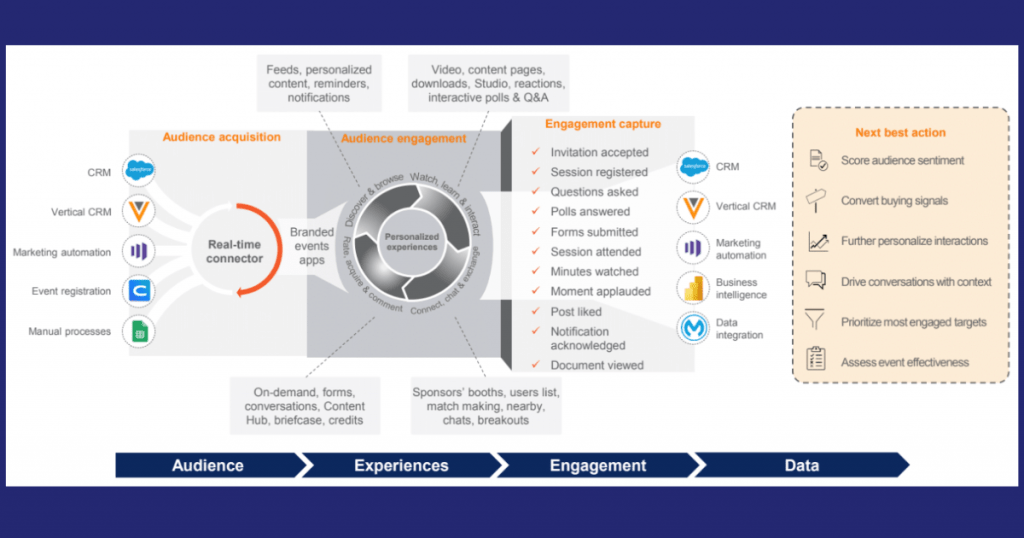
3 Types Of Event Engagement To Include In Your Strategy
Here are 3 types of event engagement to include in your strategy to help you get the most out of your event:
Pre-Event Engagement
The goal of pre-event engagement is to build momentum around your event and start getting people excited about it. Pre-event engagement also helps to raise awareness and set expectations.
Here are a few pre-event engagement ideas:
- Creating a dedicated hashtag and promoting it widely
- Running pre-event contests or challenges on social media
- Sending out engaging emails or push notifications with relevant content that leads up to the main event
- Sharing interesting facts, stories, and visuals on your activity feed
- Creating live Q&As with influencers or industry experts
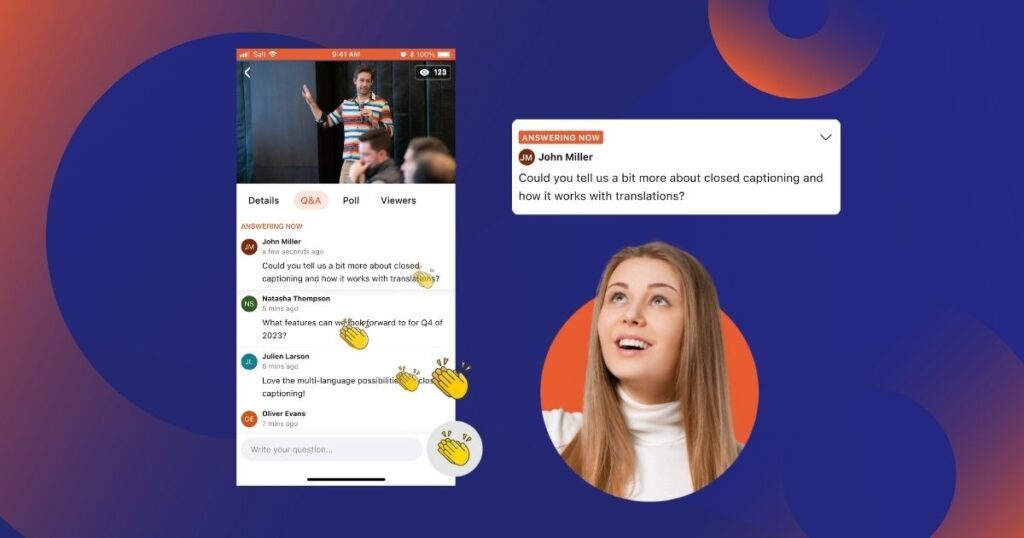
During Event Engagement
You want to keep the buzz going during your event by interacting with participants in real-time. This will also help contribute towards a memorable experience.
Here are some ideas for this type of event engagement:
- Organize interactive sessions like networking games, Q&As, and polls
- Ask attendees for feedback such as surveys and polls throughout the event
- Encourage participants to post about their experience on social media using the hashtags
- Share exclusive content during keynotes or presentations and reward those who engage with it in real-time
Post-Event Engagement
Post-event engagement ensures that you remain top of mind after your event is over. It also builds connections with attendees and helps encourage them to attend your events in the future.
Here are a few ideas for post-event engagement:
- Send out personalized thank you emails with relevant content
- Invite attendees to join related networks or groups
- Host post-event discussions and Q&As online
- Share photo galleries from the event
For ideas on how to engage your attendees in an eco-friendly way, check out our article about how to create a sustainable event.
How To Measure Event Engagement
Of course, there’s no point in investing all this time and effort into event engagement if you don’t measure the results of how effective it was. After your event, look at the data collected from your event platform and fed to your CRM. And analyze the event engagement pre-event, during, and after such as click-through rate, blog subscriptions, or video plays.
If possible, use metrics to track interactions like booth visits and demo downloads during the event. You can also track post-event activities like follow-ups and content sharing on social media channels.
By tracking these metrics, you can understand which parts of your event were successful and which weren’t so you can make changes for future events. Additionally, you can figure out what content resonated most with attendees and tailor your approach for your future events.
The bottom line is that measuring event engagement results helps you create an effective strategy that will boost ROI while giving attendees a good experience.
To get a clear view of what KPIs to measure at your events, check out our article with 19 event metrics you should be measuring.
11 Advantages Of Having A Solid Event Engagement Strategy
By putting a strong event engagement strategy in place for any event format, you can bring a lot of value to your business.
Here are 11 advantages of having a solid event engagement strategy:
#1 Boosts brand awareness
If you have great event engagement that gets your attendees excited about your event content before, during, and after, they’ll more likely spread the word about the brand, products, and services. It increases brand awareness, reach and helps you acquire new customers.
#2 Provides useful data about your audience
If you have a strong event engagement strategy that engages your audience before, during, and after your event, you’ll get to know them better. By using an event platform that connects to your CRM and feeds the engagement data directly into it, you can really understand your audience and create better content and events for them in the future.
To find out how to use your pharma CRM to power your medical events, check out our article.
#3 Builds brand loyalty
Engaged attendees become loyal customers. Event engagement helps to build long-term relationships and enhance the loyalty of those customers.
#4 Enhances customer experience
Interactive events give customers a personalized experience. This enhances the customer experience, resulting in increased satisfaction, retention, and loyalty.
#5 Generates new leads
Events provide opportunities for lead generation, where attendees can interact with your brand, ask questions, and leave their contact information. Therefore, event engagement generates new leads and helps you increase your customer base.
#6 Enables customer feedback
Events provide a platform for customers to share their feedback and opinions. This helps businesses in identifying areas for improvement and making necessary changes.
#7 Showcases products and services
Events are an excellent way to showcase products and services. Attendees get to experience the products first-hand, leading to increased interest, sales, and brand advocacy.
#8 Increases social media presence
Events are a great way for attendees to share their experiences on social media, leading to increased brand visibility, engagement, and organic reach.
#9 Provides networking opportunities
Attendees can network with each other and with your brand at events. Event engagement, therefore, helps in building relationships, collaborations, and partnerships.
#10 Improves Business Reputation
Engaging events reflect positively on your business reputation, enhancing your brand image and increasing trust among the customers.
#11 Drives sales and revenue
Engaged attendees are more likely to convert into customers, leading to increased sales and revenue for your business.
How To Boost Event Engagement At Virtual, In-person, And Hybrid Events
The success of all events, virtual or in-person, comes from event engagement, where you give attendees opportunities to interact with each other and connect to your brand. After all, events are meant to spark networking, questions, and learning.
This may seem more complicated when hosting a hybrid event, as one audience is online and one in-person, but there are many simple event engagement strategies you can use.
The first step to successful event engagement is getting a robust online event platform that can connect your attendees and speakers with fun and useful features. To find the right event platform for your needs, download our event RFP template now.
The next step is to take a look at the following 29 event engagement ideas and choose the ones that will work best for you at your next event based on the KPIs you want to achieve.
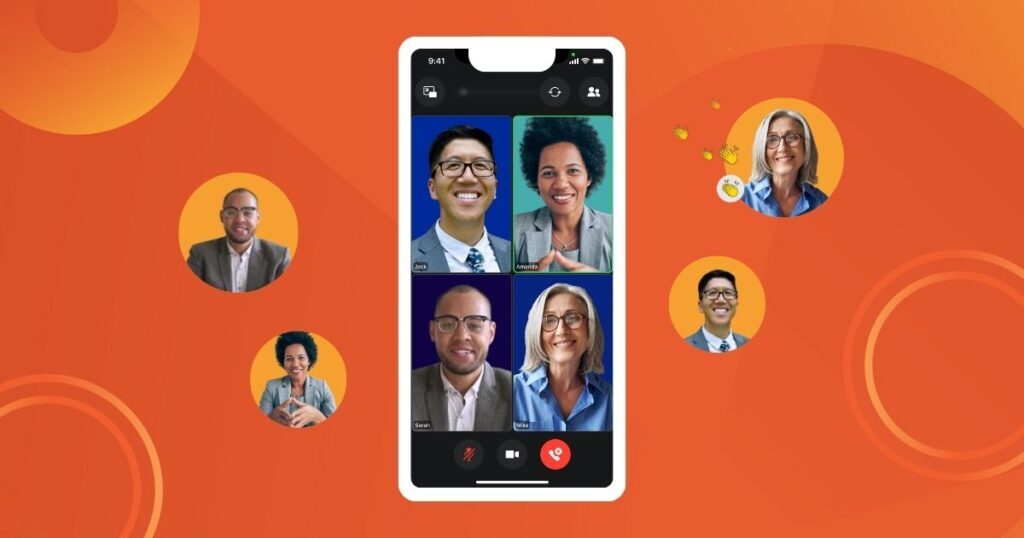
29 Event Engagement Ideas For Virtual, In-person, And Hybrid Events
11 Pre-event Engagement Ideas
Did you know that if people engage with your content before your event, they’re 60% more likely to turn up? Here are 11 pre-event engagement ideas to help you increase attendance at your next event.
Idea #1 Send pre-event engagement emails to boost attendance
“73% of global marketers consider email marketing as an excellent marketing channel. This is higher than SEO (72%) and paid search (67%).” – Influencer Marketing Hub
And with 4.37 billion people who currently use email, it’s no wonder that sending pre-event engagement emails is a great way to grab your participants’ attention before your event. Especially because it’s cost-effective and the best way to reach a specific target audience.
But we’re not just talking about sending an invitation to your event and then a “thank-you-for-registering” email. You can make the most of pre-event engagement emails to create a buzz around your event so you’ll increase the chances of people turning up. Plus, they’ll more likely tell their friends about it and bring them along too!
We’ve analyzed the millions of event emails our customers from the life science, professional services, and tech industry have been sending over the past 20+ years. And we’ve created a list of the best 18 event email templates that’ll help you get the results you want. Why not check them out?
Idea #2 Send pre-event engagement surveys and quizzes to get people engaging with your content
A great pre-event engagement technique is to send an interactive quiz or knowledge ladder. You can test how much your audience knows about your event content and use it to drive your topics, speakers, sessions, and agenda.
You could send the quiz via email or on your mobile event app. After answering the questions, attendees can see whether they answered correctly.
Hardly any companies do this, so if you start doing it, you’ll certainly stand out, because it’s something different. Plus, you’ll get your participants ready for what’s in store at your event.
Make sure you take full advantage of this event engagement method by sending out the same post-event engagement quiz. That way attendees can see how much they learned at your event.
Get more information about how successful pre-event engagement quizzes are and ideas for pre event survey questions for attendees in our blog post.
Idea #3 Allow attendees to create their own personalized agendas
People like having a choice, and events are no exception. Let your participants choose the sessions that they want to attend so they can create their very own personalized agenda.
If you give your participants the chance to select the sessions they want to attend, you’re making them think “Why do I want to go to this event?”
This event engagement technique makes it even more likely that they’ll come to your event, as they know what they will be getting from the event and are more likely to engage when they turn up.
To plan out your sessions in enough detail before your event and make sure that everything runs smoothly, you’ll need a structured run of show. Download the ultimate event run of show template now.
Idea #4 Personalize event content for each attendee
Appeal to your individual attendee’s interests by creating personalized digests to keep them coming back to your event app.
Digests are smart reminders that keep your users engaged by providing them with updates and summaries of the most popular content from their Feed, Agenda, and Messages modules.
You can create customized agendas per user, based on their interests. This can create a deeper level of event engagement activities as your attendees mainly see content that is relevant to them.
Idea #5 Create a buzz on social media as part of your event engagement strategy
Social media is a crucial part of any event engagement strategy. Creating a buzz on social media before your event (but also during and after) is key to increasing engagement, driving attendance, and generating interest in your brand.
A well-executed social media strategy can help you to create excitement, share event highlights, showcase products, and provide opportunities for attendees to engage with your brand.
By leveraging the power of social media, you can effectively promote your event, engage with your audience, and create a memorable experience for your attendees.
For other ideas on how to promote your event, take a look at our article with 41 online event promotion ideas.
Idea #6 Let attendees contribute to your content with a “submit-your-case” activity
We’ve seen event organizers do this at large life science events. And it works really well. But you can also use it for events in other industries like professional services or tech industries.
If you have a discussion panel session, you can ask your participants before your event if there’s a specific case they’d like to share. They can send you the case, you review it, see if it’s relevant and then ask the panel about it during the event. You won’t get 100 participants replying, but maybe about a dozen of which you can take two or three cases.
In this way, your participants contribute to your content and provide real-life examples. Plus, it’s so powerful to go to a panel discussion and say “Dr John submitted this case.” Especially if it’s at an in-person event because Dr John can say “Yes, that’s me!”
Your participants understand when content is genuine or fake. Real, authentic content will help boost your event engagement.
Idea #7 Interactive activity feeds that make event engagement easy
Plan content to post on a social media-like feed within your event platform. It could be teaser videos, speaker announcements, or welcome videos. Better to use your event platform as then people will actually come to the platform and discover the content. Then, once they’ve interacted with it, they’re more likely to join.
Your audience likely uses social media, like Facebook and LinkedIn, to engage with their friends, family, and professional network. That’s why activity feeds within virtual event platforms spark many interaction post ideas and work just as well for interacting with attendees.
Feeds allow hosts and attendees to share moments and insights from the event, like interactive posts with pictures or videos, where users can like and comment.
When one audience member is sitting at home, and the other is at the convention center, the Activity Feed becomes a shared place for both types of attendees to engage seamlessly.
Idea #8 Make event engagement easy and simple with a mobile event app
The world is getting more and more technological and your participants need technology to keep them engaged. One of the easiest ways to boost digital event engagement is by providing a mobile event app, no matter whether your event is virtual, in-person, or hybrid.
In-person guests can download the app on their mobile devices to receive useful notifications, view maps, and interact with virtual guests by sending messages, participating in polls and Q&As, and creating their unique user profiles.
For your virtual audience, the event app is the venue, allowing them access to attend from their mobile device or desktop.
No matter where your audience is, they can easily interact with each other and consume useful content through the event app.
Idea #9 Develop an effective registration form to understand your audience and ensure your event engagement activities work
Use your registration form as a tool to gather feedback from your audience before your event even starts. Add a question or comment box to learn how they heard about your event, what they’re looking forward to learning or suggestions for guest speakers to invite.
If you keep receiving the same questions through your registration page, consider creating an FAQ section on your registration page or event website.
Idea #10 Choose speakers who will engage both in-person and virtual attendees
Event engagement at an in-person or virtual event is different. You’ll need to have experience and practice in both to effectively connect with guests using interactive conference ideas and practiced speakers.
Don’t feel like all of your speakers should be onsite either. You can have a blend of in-person and virtual guest speakers. Just make sure that all of your virtual speakers have a high-quality camera and microphone to ensure the best video and audio quality, especially if you’re broadcasting it to your in-person audience.
Your in-person speaker should keep a laptop nearby so they can read online poll results and questions to keep event engagement high for both audiences.
Idea #11 Create different price tiers to increase your audience size
An evolving idea and one simple way to boost event engagement is to offer multiple price tiers. For example, you could charge money for an in-person ticket, but allow free basic access to your virtual attendees.
If your virtual attendees want access to on-demand content, breakout sessions, or exclusive Q&As, then they can upgrade to a paid tier for more remote access.
This simple trick can increase your event’s attendance five-fold and can demand more in terms of gaining event sponsorship, attracting more famous guest speakers, and can help you collect more data for your marketing efforts.
14 During Event Engagement Ideas
You put so much effort into getting participants to your events, but now you need to keep them there. At virtual and hybrid events, it’s easy for your online audience to leave whenever they wish. So keeping them engaged is vital.
You can use some of the pre-event engagement ideas from above during your event, all with your mobile event app, such as:
- Emails (especially if your event lasts several days)
- Quizzes
- Personalized content
- Social media
- Submit-your-case
- Activity feed
Here are 14 other ideas to keep your audience engaged from start to finish.
Idea #1 Make events as accessible as possible
Making events accessible is not only the right thing to do, it can also boost event engagement and make your event more successful.
When your events are accessible, attendees feel valued and included, which can create a positive experience and lead to higher engagement. Plus, accessibility measures can help to remove barriers to participation and create a more welcoming environment for all attendees. This can lead to increased attendance, participation, and engagement, as attendees are more likely to stay for the duration of the event and engage with the content and activities.
Additionally, by making events accessible, you can tap into new audiences and attract individuals who may not have been able to attend otherwise. Overall, making events accessible is a win-win situation, as it not only benefits attendees, but it can also lead to increased engagement and success for the event.
One way to make your events more accessible is by using live captioning. To find out more, check out our article about closed captioning for live events.
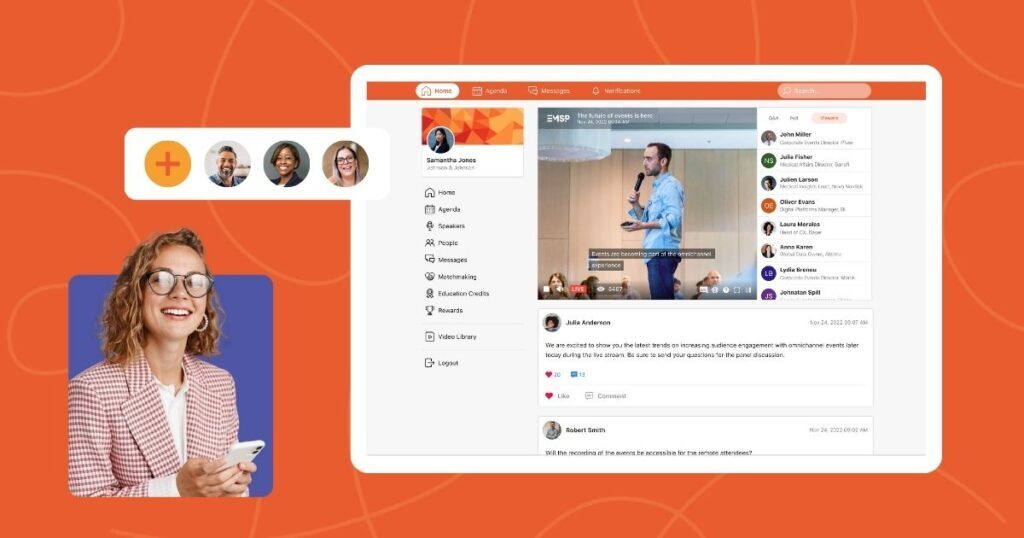
Idea #2 Keep event engagement top of mind with push notifications and daily reminders
Events can last several days, often featuring several presenters and live streams. Make sure your attendees stay up-to-date on any changes or calls to action by using notifications.
Notifications allow you to send personalized or general updates to make your audience feel included and remind them of upcoming events on the agenda. You can also inform your in-person audience about a session change or cancellation before they walk across the convention center to find it’s been canceled or relocated.
Use push notifications to increase event engagement by promoting special offers and sponsored messages to your audience.
Idea #3 Keep event engagement high with rapid-fire learning
Spending 30 minutes to an hour talking about one topic can quickly get boring. Instead, try new event engagement ideas by implementing rapid-fire learning to quicken the pace of your sessions.
This could mean spending only 10 minutes per topic, quickly followed by a Q&A session, then followed by the next topic. To boost event engagement even more, conduct polls during each rapid-fire presentation as well.
Or bring in multiple speakers to talk about the same subject, but have each speaker present for a few minutes before tagging the next speaker in. Hearing multiple speakers talking about the same subject can prevent your audience from becoming complacent.
Idea #4 Break up your presentations and vary your session formats
“If you go on for 20 minutes at a medical or scientific event without soliciting the user through Q&A, a poll, a quiz, or some sort of challenge where they have to do something, you’ve lost them. Especially if this is the third session in a row.”
Traditional congresses or conferences usually have sessions in 30 or 60-minute chunks to make scheduling easier for navigating the physical venue. But it also means your audience may hear redundant information to fill the time.
When it comes to hosting a hybrid event, what is a virtual audience going to engage in? They will quickly lose interest if sessions run too long. Remember, they’re not confined by the restrictions of a physical venue and can be more flexible in attending multiple sessions.
Event engagement ideas for a virtual conference involve breaking up the monotony of your presentations by varying session formats. Instead of saving Q&As for the end, introduce them quickly to keep a lively engagement between both audiences. Introduce breakout sessions frequently throughout to encourage participation.
Idea #5 Include meet the expert 1:1 sessions
Another event engagement idea we’ve seen work particularly well at life science events is “meet-the-expert 1:1 sessions”.
Set up sessions for speakers when they’re not presenting so that attendees can meet them on a 1:1 basis and ask their questions.
If you’re a pharma company, you can write this in your speaker contract and ask your KOL: “While you’re not speaking, could you meet 1:1 with 5 HCPs for 15 minutes each?” If you’re in another industry, you can adapt this concept.
“Everybody loves this type of event engagement because it’s personal, deeply engaging, and very gratifying. It’s also very gratifying for the KOLs to be seen as the experts and to see how many HCPs want to talk to them.”
Want to get the best KOLs speaking at your medical events? Read our article with a KOL engagement plan that’ll bring you the best ones to help you boost event engagement even more.
Idea #6 Incorporate gamification to make engaging and connecting more fun (and valuable)
Gamifying your event makes it more fun and competitive for attendees, whether they are in-person or virtual.
Use Activity Challenges to start friendly competitions within your audience. Incentivize your audience to participate in competitions by giving them points. For example, give 10 points to attendees every time they exchange virtual or real business cards with others. Have the points add up to various rewards they can win.
Or consider running a photo contest on your Activity Feed. Give a gift bag to the attendee who has the most popular photo using your event’s hashtag.
Using gamification instead of sending swag is a great way to save on event costs. Find out other ways in which you can optimize your virtual event budget and get your very own event budget template here.
Idea #7 Looking for easy-to-implement virtual event engagement? Include polls
Polling provides streamlined audience interactions with your speakers in live time, whether it’s giving feedback before or after a presentation. Polling also allows the audience to guide panel discussions with their favorite topics. Polls can be as simple as giving a star rating or asking single or multiple-choice questions.
Consider running a poll with a short time frame, encouraging users to give their feedback before the poll expires. Try to poll every 15 minutes or so to actively keep event engagement high.
By using your event app, your in-person audience can answer polls in live time alongside their virtual attendees who are completing polls on their desktops. This gives your event more accurate polling responses and unites both audiences during sessions.
Looking for more interaction ideas? Read: 20 Virtual Event Ideas to Inspire Your Upcoming Events.
Idea #8 Use breakout sessions for successful event engagement
Breakout sessions are a great way for small groups of attendees to join together to discuss specific event topics. They can be created virtually or in person with the help of a virtual event app.
By using Participant Matching, you can ensure compatibility within your virtual and in-person breakout sessions by matching people with similar interests. Virtual attendees can join their own private video chat rooms.
Try to hold several breakout sessions throughout a presentation to increase virtual engagement activities. Get creative with your meeting engagement ideas by swapping breakout room attendees each time. This allows for more networking among your audience.
Want to mix things up? Combine in-person breakout sessions with virtual sessions by bringing a laptop or tablet to the in-person breakout rooms. This can allow an online attendee to interface with in-person guests.
Idea #9 Use exclusivity to encourage guests to interact and network at special events
Be sure to allow free time for users to network with each other, virtually and in person. Create a “virtual happy hour” to increase event engagement. Attendees can browse their contact lists and connect with new people while everyone is online. Of course, you can also do this at in-person events.
Chats are a great way for users to set up private or group conversations with one another. Consider an interactive post idea where you ask fun questions on an Activity Feed post to allow others to comment and interact with each other.
Sometimes messaging online is an easier way to network, even if some guests are in-person. Having access to view attendees’ profiles is particularly useful for icebreaking and remembering connections.
Idea #10 Draw audiences in by featuring an entertainment act
Not all events have to be 100% serious. Lighten the mood by bringing in a performer like a magician, comedian, or musician to entertain your audience.
Attention spans tend to be shorter for virtual audiences, so providing entertaining and stimulating content allows them a chance to take a mental “breather” and relax, so that when your regular programming starts again, they’ll be sharper and more engaged.
The entertainment can help attendees strike up conversations over their shared experiences.
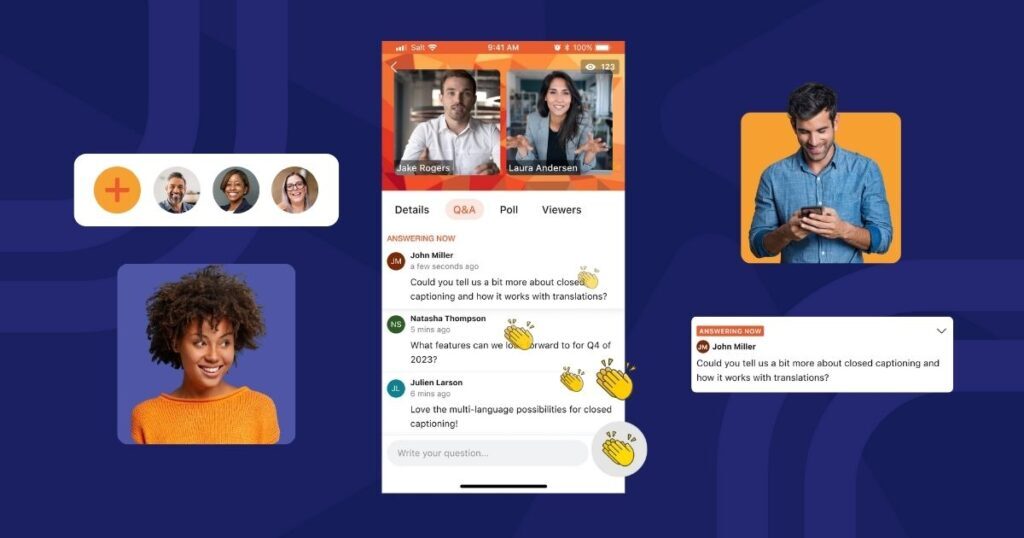
Idea #11 Let attendees in on the action with live Q&A and applause
When exploring event engagement ideas, remember that one of the main draws for attending conferences or congresses is the opportunity to ask questions and receive answers from experts.
Using Live Q&A, participants can ask questions before and during a live stream. If your in-person audience members are shy, they can ask questions through their event app instead, giving you more ways to connect with both audiences and track the conversation.
Using a moderation panel allows the moderator to see user-submitted questions to pick and choose what questions are displayed for the audience.
Instead of clapping to show approval for your guest speaker, attendees can press the “applause” button to react. Data insights gathered during presentations, like applause, can be analyzed to see what moments were the most popular among the audience.
Idea #12 Offer both live-streaming and on-demand presentations
Creating an organized agenda filled with live speakers makes your event feel lively and urgent, and can encourage event engagement from attendees. But you should also add on-demand content to your virtual or hybrid event for your audience to browse.
It’s simply not possible for attendees to watch or attend every presentation. Sometimes their schedules or attention spans simply won’t allow it. By adding on-demand content, you allow attendees to learn at their own pace and get as much as they can from your event.
Idea #13 Develop different content for virtual attendees at a hybrid event
When hosting events that are more suited toward in-person attendees, you have to get creative with your event engagement ideas to appeal to your remote attendees so they don’t lose interest.
Your virtual audience is more flexible than those visiting in person. They can consume content much faster. Especially if you add on-demand content to your hybrid event.
On-demand content lets your virtual audience pick and choose how they engage with your conference’s information. This can include uploading past webinars, infographics, pre-recorded videos, case studies, blog posts, and other interaction post ideas.
Idea #14 Work with an event production partner to enhance your production quality
Want to create a hybrid event environment that will wow your audience and get them talking? Work with an event production partner who can create an unforgettable experience for your guests and boost event engagement sky-high.
A production company can improve your set design and venue space to transform your event. They can also improve your live streams by upgrading audio and visual quality for your remote audience. And that will reduce “Zoom fatigue.” This creates a more enjoyable virtual event experience. Plus, people are more likely to engage with your presenters.
Looking for a company to help you with virtual event production and hybrid event production. Consult our curated list.
4 Post-event Engagement Ideas
Your event is over, but it’s not time to stop with the event engagement yet. You don’t want your attendees to forget about your event or your brand. You want to get as much information you can. That way you can collect enough data in your CRM to help drive you your next best action.
Here are 4 post-event engagement ideas:
Idea #1 Publish event content on your gated content hub
Turn your live events into on-demand videos that your audience can watch whenever they want in just a few clicks. Give everyone who attended your event access through your event platform.
Those who watch your event on-demand will engage with your content through live engagement replay. Viewers clap along while watching on-demand content and see polls, Q&A, and applause at when they happened during the live recording. This helps boost post-event engagement as they feel like they’re there.
By having a gated content hub, you can invite people to view your events on-demand. And it’s compliant with regulations and gives you even more first-party data insights.
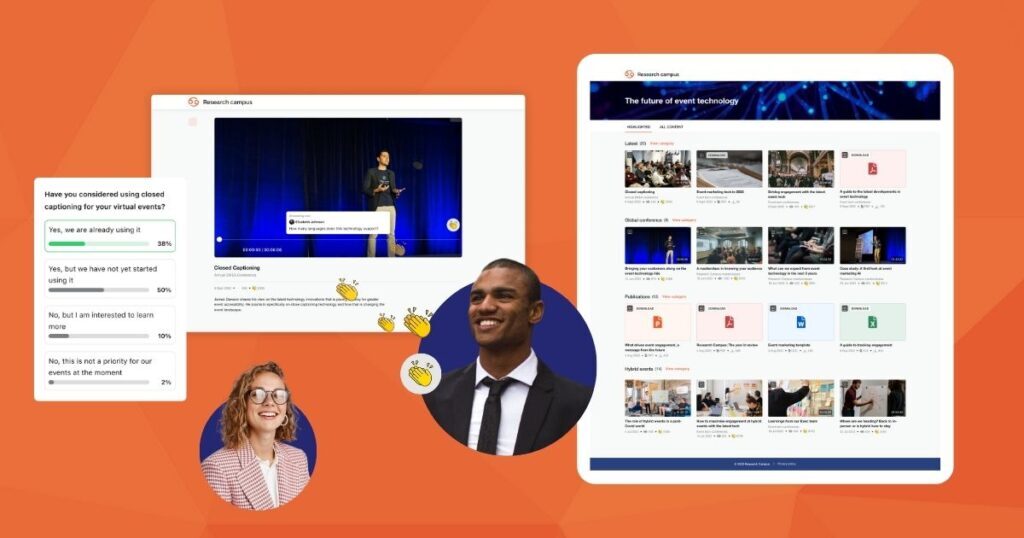
Idea #2 Find out what worked best through post-event surveys
Send a post-event thank-you message and ask your attendees for their feedback. Was there a certain session or speaker that resonated with them? What can you improve upon?
A lot of your user-collected data can tell you which sessions were the most popular. But, asking direct questions through surveys can help you determine your brand’s sentiment. And what your users actually thought of your event. Then you can produce an even more engaging event next time.
Our life science customers boost their survey response rates by offering an attendance certificate in return.
“Nobody wants to do a post-event survey but everyone wants an attendance certificate. Give them the certificate only after they do the survey. A simple trick that will get you a 60/70% response rate.”
Once you have feedback from your attendees, you’ll want to act on it. Collect important responses in your event debrief template to discuss in your debrief meeting.
For a structured event debriefing, download the ultimate event debrief template now.
Idea #3 Send a post-event quiz
Remember that pre-event engagement quiz you sent? Well, now it’s time to send that very same quiz after your event. Especially if it was a knowledge quiz. Your attendees will be able to see first-hand what they learned.
Send the quiz on your mobile event app. That way all the data feeds back to your event platform and into your CRM.
You could even give them some sort of reward for completing the quiz. And give them a prize if they get a better score than last time.
Idea #4 Invite attendees to your next event
Inviting attendees to your next event after an event is a smart move that can help increase event engagement and attendance rates. When attendees have had a positive experience at your event, they are more likely to attend your future events. Especially if they receive a personal invitation.
Inviting attendees after an event shows that you value their attendance and want to continue the relationship beyond your event. Plus, it gives you a chance to collect feedback and insights from attendees. Things you can use to improve future events. Plus, it can help to create a sense of community and belonging.
By staying connected with attendees, you can build a loyal fan base that will continue to support your brand and attend your events in the future. Overall, inviting attendees to your next event after an event is a great way to maintain engagement, build relationships, and increase attendance rates.
The Event Platform That Focuses On Event Engagement And Feeding Engagement Data Into Your CRM
Now you’ve got lots of ideas on how to boost event engagement at your virtual, in-person, and hybrid events. It’s time to find an event platform that can do it all.
One that has so many integrations that it can automatically send all the engagement data to your CRM. That way, you have a single source of truth to use for your next best action.
SpotMe was named a Leader in The Forrester Wave™: B2B Event Management Technology, Q1 2023. “Its superior vision focuses on creating engaging audience experiences and interactions to enrich CRM records.” To see how SpotMe’s all-in-one enterprise event management platform can increase event engagement to bring value to your business, book a free demo.



